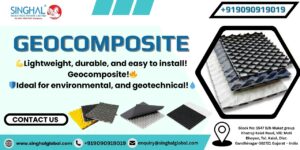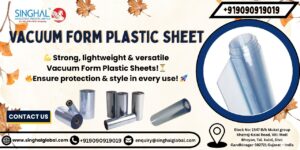Geotextile’ can be divided into two phrases, ‘geo’ and ‘textile’. Geotextile is an extension of technical fabrics. Geotextile is a particular kind of polymer material (polyester, polypropylene, etc.) with very tiny holes that are utilized to enhance soil properties in civil construction tasks.
Geo fabric sheet is a perfect textile fabric for roads, ports, trash yards, breakwater structures, drainage configurations, and other civil undertakings.
Kinds of Geotextiles:
Geo-textiles are distinguished synthetic fabrics manufactured with textile materials. These are usually created from polymers like polyester and polypropylene. There are four major kinds of geo-textiles
- Woven Geotextiles: These classifications of materials perform the process of separation and growth of the power of the soil. As the yarn stability of their warp is much increased, they have more tensile strength. As a result, it can take much more burden. There are various combinations of woven geotextiles like woven monofilament, woven multifilament, woven slit-film monofilament, and slit-film multifilament. There are various Geotextile Manufacturers in India are available who produce this type of Geo Fabric Sheet.
- Nonwoven Geotextiles: In the case of nonwoven geotextiles, tensile power is not very elevated, but their Divergence, Drainage, and Filtration capacity are better than others. Non-woven geotextiles are porous geosynthetics, usually created by synthetic fibers. Thermal and chemical bonding is also used to make non-woven geotextiles. There are various mixtures of nonwoven geotextiles like continuous filament heat bonded, constant filament needle punched, staple needle punched, and resin bonded.
- Knitted Geotextiles: These sorts of geo fabric sheets have good flexibility and are economically beneficial. Although its usage is less, the need for “Drainage and Soil Erosion Control” is rising day by day. Knitted geotextiles are created by utilizing knitting technology, sometimes weaving is utilized to create these derivatives.
- Spunbonded Geotextiles: In the world of material production, the spun-bonded procedure is contemplated as the fastest production technique for non-woven fabrics. During the procedure, the extruded filaments are sliced into the belt and the rolls are heated and held together.
- Braided Geotextile: Braiding is normally utilized for producing thin rope-like materials by tangling obliquely three or more strands of filaments or yarns. The topology of strand interlacements in braided configurations is identical to that of woven structures.
Threads Utilized to Make geo fabric Sheets Both natural and manmade fibers are utilized to create geotextiles. However, the most utilized is manmade (synthetic) fiber.
Natural Fiber: Natural fibers are compiled from natural origins like Plants (leaves, kernels, barks, etc.), Animals, Minerals, etc. Geotextiles, which are created from natural threads have some aspects like robustness, durability, stability, good drape capacity, and biodegradability. However, natural fibers are utilized less than before in making geotextiles.
Man-Made or Synthetic Fiber: Geotextiles, which are created from synthetic threads, are called geosynthetics. So, all geotextiles are not geosynthetics but all geosynthetics are geotextiles. Polyester and Polypropylene are most normally utilized in creating various kinds of geotextile products. Singhal Industries is known as the best geo sheet manufacturer in the country.
Features of Properties of Geotextiles
Physical Properties:
- Distinct gravity
- Weight and consistency
- Immobility
- Thickness
Mechanical Properties:
- Perseverance
- Tensile stability
- Compatibility
- Flexibility
- Rip resilience
- Frictional resistance
Hydraulic properties:
- Porosity
- Permeability
- Permittivity
- Transitivity
- Soil retention
- Filtration
Degradation Properties:
- Biodegradation
- Hydrolytic degradation
- Photodegradation
- Chemical degradation
- Automated degradation
Persistence Properties:
- Elongation
- Abrasion opposition
- Plugging up length and flow etc.
Applications of Geotextiles:
Geotextiles are utilized in different infrastructural works, which boost the stability of weak natural muds and prevent deterioration. As a result, problematic places become reasonable for building / civil structures.
Some of the notable uses are-
- Provisional & Permanent Roadways, Parking lots & Construction locations
- River, Canals & Coastal works.
- Filtration & Drainage
- Divergence
- Farming
- Railway works
- Reinforcement
- Protection & deterioration control
- Maintaining wall structures
- Barricades etc.
Advantages of Using Geotextiles
- Geotextiles are utilized to safeguard seaside property from sand waves and floods. Geotextiles can enhance soil stability at a lower expense than traditional pipes.
- Geotextile plays a crucial part in drainage and is utilized in playgrounds.
- Coir geotextiles are famous for eroding supervision and biotechnology, due to the important mechanical resilience of the material. To enrich the soil, the derivative moisture is reduced.
- Geotextiles are utilized vastly as dividers of the two coatings of soil. Jute geotextiles are used to stave off mountain landslides.
Major Functions of Geotextiles:
Geo-textiles are normally utilized to enhance the soil on which roads, dams, pipelines, and large infrastructure are constructed. There are various geotextile fabrics for various properties like divergence, filtration, and safety.
- Geo-textiles for Separation: To maintain the features of two different varieties of soil, geo-textile plays an important part in this divergence. The major objective of this kind of geo-textile is that when water enters the soil layer, the geo-textile will stave off water from blending with the soil. Also, during road structure, it assists in keeping fine sub-grade level soil separate from the lower coarse soil. Whenever you want to purchase these sheets then contact Singhal Industries as we are the leading Geo Sheet Manufacturer.
- Geotextiles for Reinforcement: When geotextiles are utilized to enhance soil properties, their design is established on several basic characteristics, such as abrasion-capable, load-bearing, etc. As an outcome, it bolsters the soil by mixing with the soil. So, these kinds of textile fabrics are utilized to create embankments/roads on very poorly graded soil. There are different kinds of reinforcement composites like threaded reinforcement, braided reinforcement, woven reinforcement, etc.
- Geotextiles for Filtration: Geotextiles play an important role in filtration. Filtration is one of the most crucial processes of textiles utilized in civil engineering earthworks. Hanging on the permeability of the fabric, geo-textiles increase the lateral flow of drain water, formulating the kinetic energy of groundwater. Also enables them to solve drainage problems around the house or on the street.
- Geotextiles for Sealing: A non-woven geo-textile fabric competent for prohibiting liquid flow from both sides. Impermeable geotextiles are utilized to stave off contamination of adulterants above foul-smelling muds or groundwater.
- Geo-textile in Drainage System: A geotextile acts as a drain when it compiles and carries the fluid or gas towards the outlet. Dense non-woven geotextiles provide an option for water flow through a three-dimensional flat texture.
Geotextile Installation Procedure
The first step in any installation project is selecting the right geotextile to utilize. From woven to non-woven, various kinds of geotextiles are excellent for various projects. If you’re unsure about what geotextile you require, consult one of our specialists.
Once you’ve found the excellent geotextile, you’re ready to establish your material. Follow these four easy processes for how to install geotextile.
1. Ready the Site
Before laying down your material, you’ll be required to ready the site. How ready you are can vary depending on what you intend to utilize the geotextile for. However, most sceneries will require a level texture free from depressions or elevated areas.
For most projects, you’ll also want to withdraw the topsoil and vegetation coating. This can pertain to removing trees, rocks, grass, and more. The standard surface for a stable project is a smooth and level area of soil.
2. Install the Fabric
Once your site has been readied you’re ready to install your geotextile fabric. Roll out the fabric over the soil so that it sits flat over your prepared area. You’ll want to overlap the laid-out fabric slightly to create the utmost support.
3. Secure with Staples
After you’ve gotten your geotextile material into place, you’ll need to ensure the fabric properly. Staples can be used to anchor your material down.
4. Add the Base
Geotextile derivatives are utilized to disentangle layers and build additional support. To finish installing your material, you’ll want to add your top coatings. Add whatever you’re utilizing to build your base layer above the secured geotextile. This can be crushed rock, gravel, or another material.
The amount of fabric to utilize as a base will depend on your task. Construction that requires more load-bearing capacities will likely need a deeper and sturdier base.
Conclusion
We got to know what are Geo Fabric Sheet all about. There are various geotextile manufacturers in India are available but Singhal Industries is the best among them.
FAQs
Why do we use Geotextiles?
Geotextiles are an ideal safety from deterioration of earth barriers by wave action, currents, or repeated drawdown. A coating of geotextiles can be placed to prevent leaching of fine fabric. They can be utilized for rock beaching or as mattress configurations. They can even easily be placed underwater.
What is the Purpose of a Geotextile membrane?
Geotextile membranes can be utilized as a filtration mechanism. In many cases, drains get blocked up with garbage, which causes flooding and other problems. When a geotextile membrane is utilized, water passes through the membrane, but any other debris or larger particles are staved off from penetrating the drainage system.
Why is Geotextile used in Waterproofing?
Geotextiles protect and disentangle a membrane from a structure. With their pre-brake elongation capability, higher than other fabrics such as glass mesh or fiberglass mesh, they can follow the movement of elastomeric waterproofing fabrics, accomplishing reinforcement and long-term durability.









